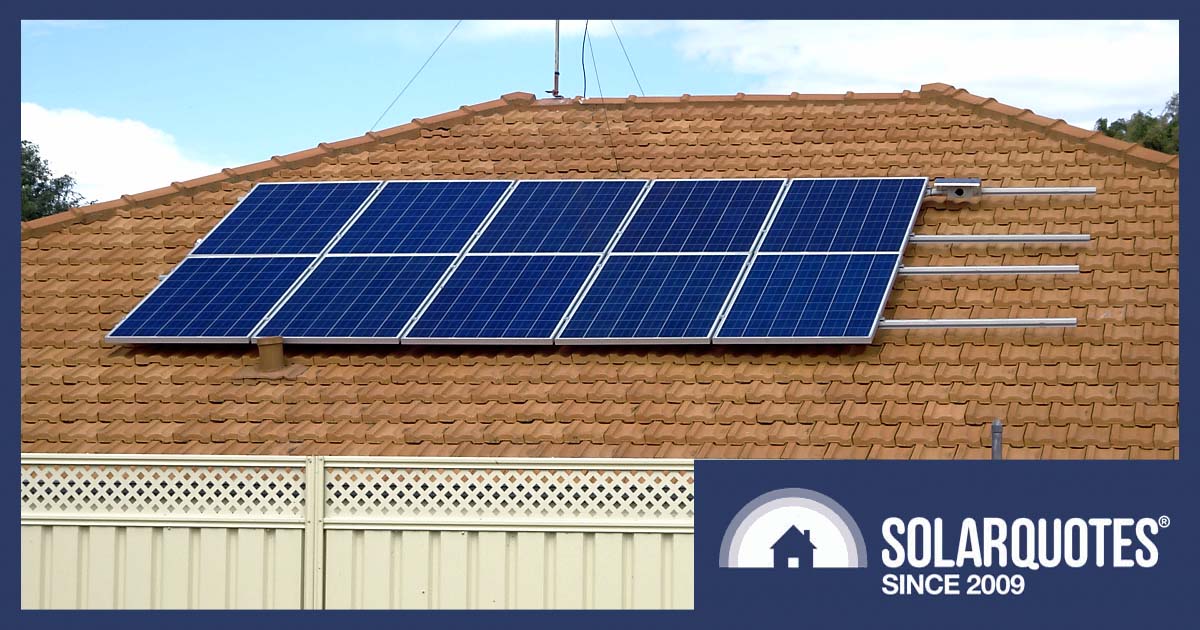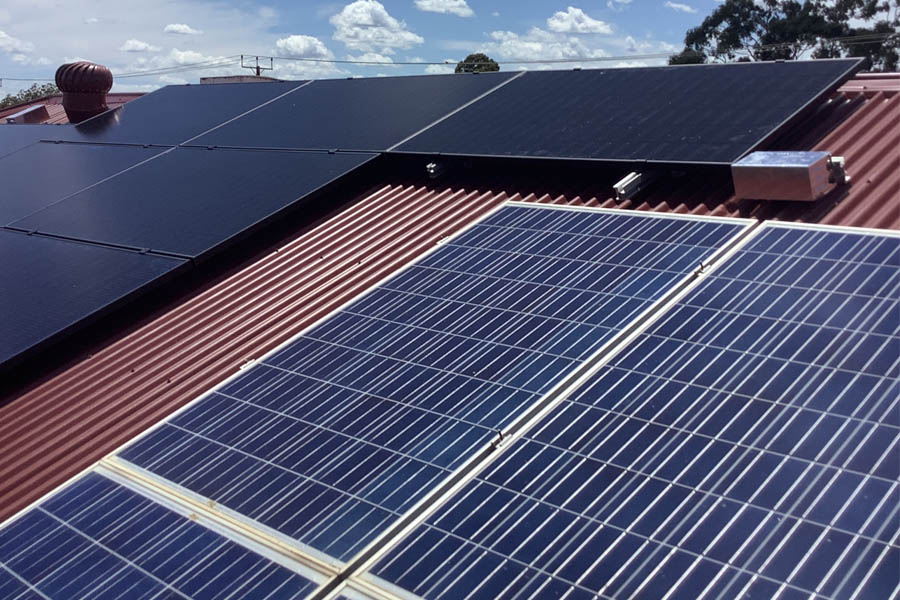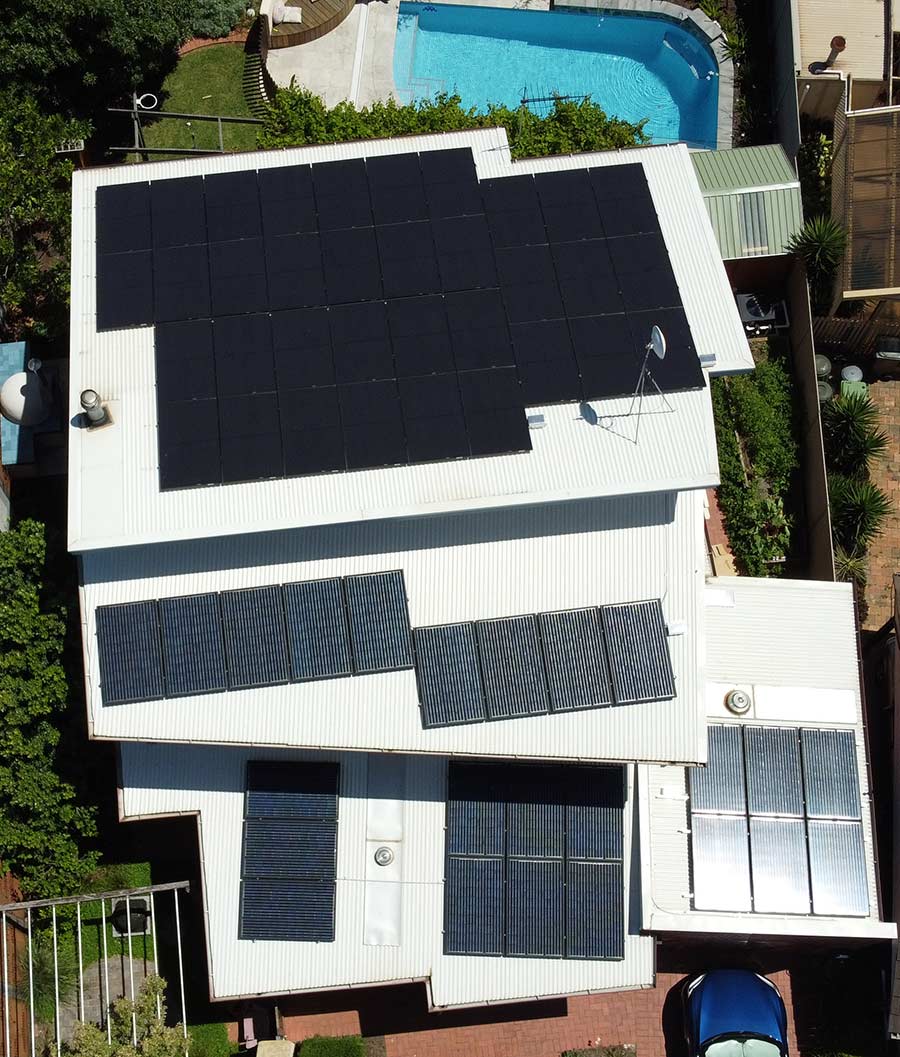
If you want to increase the size of your existing rooftop solar system, you typically have 4 options for upgrading:
- Add solar panels to your existing string inverter (if that’s possible).
- Add panels with microinverters.
- Add a second solar power system.
- Remove (or move) the old system and replace with new.
I’ll go through each upgrade option to help you decide the best one for your roof.
Option #1: Add Solar Panels To An Existing String Inverter
When dinosaurs roamed the earth and I worked as a solar installer, it was common to design and install a system where the inverter was bigger (in kW) than the solar array. Fast forward to today, and the opposite is true.
The idea behind using an oversized inverter was that panels were getting cheaper every year and could be added later.
With hindsight, although well intended, it wasn’t always a great idea. Some cynical people would say this was just a money grab by solar installation companies, but I disagree. Many people did upgrade with additional panels after the initial install.
You had to be quick though, as time and technology wait for no one. These legacy systems haven’t quite gone the way of the dinosaurs yet. Many are still going strong, but the idea that you can just add on more solar panels is, in most cases, not viable anymore.
Here are six reasons adding panels to an existing system is no longer common:
1. System is underperforming.
If the output is not what it used to be, get the system checked out. Simple. This is the starting point. Find out what the problem is with a professional before you think about an upgrade.
2. They don’t make the same panels anymore.
It’s desirable to use the same brand/model solar panels, both for aesthetics and performance. If they’re not available it’s possible to use other brands, but any mismatch in electrical characteristics will result in compromised output.
3. Your inverter may be at its capacity.
Inverters have an upper and lower voltage and current limit. If it’s already maxed out with the panels you have, it’s game over with regard to expansion for that particular solar system.
4. It’s not economically viable.
The cost of labour plus equipment, panels, rail extensions, etc adds up and will most likely not pay for itself over the remaining life of an old system.
5. Legal stuff.
If a solar power system is altered, it’s subject to the current electrical regulations and Australian Standards. In this ever-changing industry, that means you’re probably up for additional costs of compliant earthing, roof-top isolators, and wiring enclosures.
6. If it ain’t broke, don’t fix it.
When stuff gets old and you touch it, you could be opening a can of worms. I can think of a few idioms here, but I’ll run with this one – “If it ain’t broke don’t fix it, because if you do try to fix it, then it surely will be broke” (and so might you).
Option #2: Add Panels With Microinverters
If your heart is still set on an expandable system, microinverters are a good option. Unlike a conventional string inverter, each panel has its own micro-inverter, so you can add on panels as you like; the only limitation being your DNSP rules.
You won’t be restricted to using panels of similar size and power, which may not be available in the future. Other advantages are (theoretically) increased output, panel level monitoring, improved safety, no weakest link effect, and longer warranty.
Sound pretty good? Jessica Macpherson from Adelaide company NRG Solar is a big fan.
“I think the value of scale-ability using micro-inverters has been underappreciated both by industry and customers. People typically, instead, get a 6.6kW system string inverter system, and think that it’s plenty.”
“The next thing, they buy their model 3 Tesla and it’s not enough to cover their house, hot water, space heating and cooling, and car.”
“With a microinverter system, if you add, say, four panels on, you receive the full benefit of those panels without being held to the restrictions of an oversized string inverter system, and you have more flexibility.”
One of the downsides of micro-inverters is the expense. That’s why most people opt for another string inverter system instead when upgrading, sitting next to their existing one. That’s assuming you have enough roof space.
Option #3: Add A Second System
If you have an existing solar system and are thinking of upgrading, don’t despair. You can have a nice shiny new one installed to work in tandem with the original system, so there’s no need to throw the baby out with the bathwater.
Jessica says lately they’ve had a spike in enquiries from customers wanting to upgrade their aging solar systems.
“Many customers have some misinformed or maybe outdated ideas around what upgrading a solar system entails. A lot of people are under the impression that they can add a couple of panels easily, and that will make quite a bit of difference.”
She finds herself often having to explain, for example, that they could technically add a couple more panels, but in many cases it’s not going to have much impact on maximum production for that system.
The increase in upgrade enquiries is driven by existing solar owners wanting to jump on the home battery and EV bandwagon, and also from early solar adopters whose systems are no longer meeting their needs.
“As a product of their time these legacy systems have done really well. However, the reality is that a 1.5 kW system installed ten years ago is probably no longer appropriate in size.”
“Many people who have older systems are stuck in the high feed-in tariff conversation. This may be holding them back. If they need more energy to support their growing needs, a high feed-in tariff isn’t going to help.”
Sure, your feed-in tariff is part of the conversation, but nowadays it’s all about designing a solar system that matches your energy use and maximizes self-consumption of solar electricity. Perhaps it’s time to run the numbers again1. Jessica certainly thinks so.
“If a system is sized right, it will be the right call. If you have someone who puts the time and effort in to run the numbers, it’ll make it pretty clear if an upgrade is a good idea for you or not. It’s about finding a solution that’s appropriate for the customer’s needs.”

The old and the new side by side. Image NRG Solar
Option #4: Remove (Or Move) The Old System
If roof space is in short supply at your place, and the current system is hogging the prime roof area, it might be time to pull the old, relatively inefficient solar panels off.
These days solar panels are more efficient. Although larger in physical size, each panel is typically up to twice as powerful as a decade ago. In most cases, if you’re looking to upgrade, it’s best to start with a blank canvas.
When SolarQuotes founder Finn upgraded his setup, he removed his old 16% efficient panels (Tindo Karra + SolarBridge microinverters). He filled the prime north-facing roof space with the latest 21% efficient panels (REC Alpha Pure + Enphase IQ7A microinverters). He managed to get 14 kW where only 6 kW was before2. Finn tells me his bills are back to credit, despite the addition of 110 kWh of electric cars, electric hot water, and a 57,000-litre heated pool.

Finn’s recent upgrade. Up is north. You can see the improved efficiency of the 14 kW of new panels (dark black) vs the old 6 kW system which is now on the sub-optimal roof areas.
Run The Numbers With A Good Installer
Do your research. If you’ve read this far you’ve already started the process. Most importantly, talk to a professional about your solar upgrade options. Don’t be afraid to remove your old system – which has likely paid for itself many times over.
I’ll leave you with this valuable advice (again) from Jessica:
“If you have someone who puts the time and effort in to run the numbers, it’ll make it pretty clear if an upgrade is a good idea for you or not. It’s about finding a solution that’s appropriate for the customer’s needs.”
Footnotes
- Ronald has run the numbers for you. While you’re at it, you better read this about solar upgrades. ↩
- Some further details: He also removed a Solahart hot water heater from the roof and replaced it with a heat-pump. He couldn’t bear to part with his 10-year-old panels, so he moved them to the heavily shaded west and south-facing roof. ↩

 RSS - Posts
RSS - Posts



I currently have 6kW of solar on the east side, and a 5kW Bosch inverter. I want to increase this to 10kW.
I have had a quote for 4kW of panels, which would be installed on the west side, and a second 5kW inverter.
The idea is to increase production overall but also to increase afternoon production to meet our usage.
I have an EV that I charge when the sun is shining and may add a battery at a later date.
Can someone explain how I would go about monitoring the two systems? Is there software or an app or would I have to rely on inverter manufacturers monitoring software?
Solar Analytics software with a WattWattcher meter could monitor both systems with one dashboard.
Presumably you’ve already checked the DNSP rules link in the article above, but if not, and if you plan on connecting the second system to the grid, make sure your area supports it. Some places restrict exports to 5 kW.
Do you have resistive loads e.g. electric geysers fed by the inverter? If so there may be a simple inexpensive option by taking these off the inverter and feeding direct dc controlled by the inverter system. If you have Demand Side Management (DSM) with data acquisition and control even better; using normally open and normally closed contactors in parallel you can run the geysers with peak clipping and feed to the inverter when you need more juice “afternoon”.
I took Option 4 in October 2021. HUGE upgrade to my home’s rooftop solar to LG/Enphase combo. Best move EVER!!!!
I have a system that was installed in 2010. It is a 1.5 kW system with an 8 kW inverter. My current feed-in rate, Victoria, $0.72 per kWh with another Eight (8) years at least to run.
This system provides about $40 per month, during summer, and obviously less during other seasons.
My system in Canberra is 6.6 kW and is mostly consumed over the day (during COVID) but the feed in tariff is just 7 cents per kWh.
I am not sure what to do with the Victorian system replacement of a system which is still generating around 90% efficiency seems silly. Your advice would be appreciated.
Regards
Chris
Hi Chris. Looks like you’re between a rock and a hard place. 72 cents/kWh feed-in tariff is not to be sneezed at. When running the numbers it’s important to use data covering a full year or two. Without the full year it is skewed. I’d be making a spreadsheet with all the options available to you and a breakdown of each one with costs vs expected returns over lifetime (the systems not yours). If you can’t do that yourself then get quotes where they can do it for you.
Hi Chris. As far as I’m aware, the Victorian PFIT started in 2009 and was legislated to run 15 years. It’s scheduled to finish in (I believe) November 2024. The PFIT is $0.60/kW/h and retailers can kick in whatever they want on top of that.
I don’t think your PFIT has 8 years to go. Of course, I stand to be corrected on this matter, but I looked into it when I had a 4.9kW system installed on my home’s roof in 2010.
Cheers
We’d like to add more panels to our 1 yr old 6.6kW system, but the regs here in WA changed earlier this year to say that :
AS5033.2021 clause 2.1.6 (mark 1)
Requires the panels connecting to one MPPT have the same technology and similar electrical characteristics.
So they don’t have Jinko Tiger N 370W panels any more. We can get Sunpower 390W panels, but then the regulator would see a mismatch and we wouldn’t get the STC’s.
Then the optimisers that are an issue…. 450W Huawei are not available any more, as they were replaced by 600W.
So, we either replace ALL the 1 yr old optimisers to be 600W (very expensive), or can’t update (unless we can somehow source a number of 370W panels AND 450W optimisers).
Anyone got some 370W panels and 450W Huawei optmisers for us?
I have 1 kw solar on my north side, 1.5 on the west. Currently the system is working well. However, the north side is at least twelve years old, the other much newer and I would like to upgrade the north side. Also, my payback will decrease considerably in 2024. I live in a unit, most of time alone, so I do not need a big system. I would like to scrap the panels on the north side as soon as possible. What size system is useful for my purposes on the north side?
Thank you
Sharon Marmor
Melbourne
Hi Sharon. I don’t know what size your roof is, your consumption, or feed-in tariff, but if you say you want to scrap the panels on the north side I would suggest installing as many panels as can fit regardless of your usage. This is because the price per kW is more for the small systems and so payback would be longer. Other than that, keep the original system and add panels with micro-inverters. Get some quotes from installers and see where it goes.
Hi,
I have panels just over 10 years old. 6 Panels (west facing roof, VIC), 3 micro inverters. They seem to be working fine but need more power now, as planning to go full electric house, possibly with battery in future.
Could I upgrade these, expand them? or should i start again?
thanks for any advice.
There’s another option where you can upgrade to an inverter with more output and 3 mppt (GoodWe MS series) if you currently only have 1 or 2 mppt on the existing inverter.
Add a new string of panels on the new mppt.
I have had an off grid system for a year with a vitron 5 kWh inverter which doesn’t allow me to use my oven that is 3200 kWh with out shutting down the system ( I don’t have anything else in use except frig.) I also need to run a small split heating system. What do I need to do to allow more power to the house. I have 3 batteries which are full most of the time and 16 seraphin panels.
I’ve had a quote for a bigger inverter, is this the way to go. It is an expensive option.
What would you advise.
Thanks
Hi Susan,
We’d need a lot more detail in order to be able to help sorry. Brand, model, age and battery voltage would be a start.
Hi,
I have an exisiting 13.2kw system on my house. I have been told and confirmed with Energex that I am allowed another 13.2kw system on the roof as long as I have an AC coupled battery and no feed in from it.
Can anyone talk me through what battery? And extra equipment I many need? I’ve heard I need an CEC approved BESS battery and some other dynamic / communication equipment?
Many thanks,
Hi Sam,
With 17 different DNSPs in Australia I’m not across all of them but if they’re calling for an AC coupled battery then I’ve been told you can use a hybrid like Tesla PW3 and simply not connect solar on your connection application.
Search our blog for “powewall alternatives” and you’ll find a (somewhat dated) article on other AC coupled batteries.
Or go over our battery comparison table.
At the end of the day you’ll need advice from an installer familiar with your place & the local rules.
Hi I have a 2yr old 3phase 8kw inverter and 10kw worth of Panels
My installer says I cant add any more panels due to Western Power oversize Limit rules
8kW inverter + 33.3%
I have a 1.5kw export limit, And Plenty of reserve capacity on the MMPT.
I cant find any information that says I cant add more panels on Western Power Site.
Has anyone heard of such limitations.?